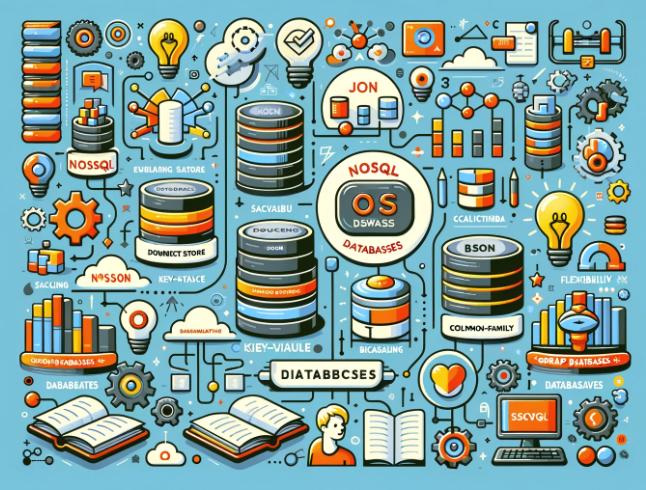Introduction to NoSQL Databases

AI generated for NoSQL Databases
Importance of NoSQL Databases
NoSQL databases are designed to handle large volumes of data that do not fit well into traditional relational databases. They provide a mechanism for storage and retrieval of data that is modeled in means other than the tabular relations used in relational databases. NoSQL databases are widely recognized for their high performance, scalability, and flexibility in handling diverse data types.
Key Features of NoSQL Databases:
- Scalability: Easily scale out by distributing data across multiple servers.
- Flexibility: Handle unstructured, semi-structured, and structured data.
- High Performance: Optimized for specific data models and access patterns.
- Schema-less: Dynamic schemas allow for rapid iteration and agile development.
- Distributed Architecture: Data is distributed across many nodes, ensuring reliability and availability.
Uses of NoSQL Databases
NoSQL databases are used in a variety of domains, including:
- Big Data and Analytics: Handling large volumes of structured and unstructured data.
- Real-Time Web Applications: Supporting high read/write throughput.
- Content Management Systems: Flexible schemas for varying content types.
- IoT Applications: Storing and processing massive streams of data from IoT devices.
- E-commerce Platforms: Handling diverse product catalogs and user data.
Top-Tier Companies Using NoSQL Databases
Several leading companies rely on NoSQL databases for their critical systems and applications:
- Amazon: Uses DynamoDB for its e-commerce platform.
- Netflix: Uses Cassandra for its streaming service.
- Facebook: Uses HBase for messaging and real-time analytics.
- Google: Uses Bigtable for various internal services.
- Twitter: Uses Redis for caching and real-time analytics.
NoSQL Database Types and Learning Roadmap
The roadmap is divided into three main levels: Basic, Intermediate, and Advanced. Each level builds on the previous one, ensuring a comprehensive understanding of NoSQL databases.
Basic Level
- Introduction to NoSQL
- History and evolution of NoSQL databases
- Differences between NoSQL and SQL databases
- Types of NoSQL databases (Document, Key-Value, Column-Family, Graph)
- Setting Up Development Environment
- Installing NoSQL databases (e.g., MongoDB, Redis, Cassandra, Neo4j)
- Basic configuration and connection setup
- Basic Operations
- CRUD operations (Create, Read, Update, Delete)
- Data modeling and schema design
- Indexing and querying
- Document Databases
- Introduction to MongoDB
- Basic operations and data modeling in MongoDB
- Querying and indexing in MongoDB
- Key-Value Stores
- Introduction to Redis
- Basic operations and data modeling in Redis
- Using Redis for caching
Intermediate Level
- Column-Family Stores
- Introduction to Cassandra
- Data modeling and partitioning in Cassandra
- Querying and indexing in Cassandra
- Graph Databases
- Introduction to Neo4j
- Basic operations and data modeling in Neo4j
- Querying with Cypher in Neo4j
- Advanced Data Modeling
- Designing for performance and scalability
- Handling relationships and joins in NoSQL
- Indexing strategies
- Querying and Aggregation
- Advanced querying techniques
- Aggregation frameworks (e.g., MongoDB Aggregation Pipeline)
- Full-text search and indexing
- Replication and Sharding
- Understanding replication and consistency models
- Implementing replication in various NoSQL databases
- Sharding and partitioning strategies
Advanced Level
- Performance Tuning
- Monitoring and profiling NoSQL databases
- Optimizing queries and indexing
- Scaling NoSQL databases
- Security
- Authentication and authorization mechanisms
- Data encryption at rest and in transit
- Implementing role-based access control
- Backup and Recovery
- Backup strategies and tools
- Implementing disaster recovery plans
- Restoring data from backups
- Distributed Systems Concepts
- Understanding CAP theorem and its implications
- Consistency models (Eventual, Strong, Causal)
- Handling network partitions and data replication
- Integration with Other Technologies
- Integrating NoSQL databases with Hadoop for big data processing
- Using NoSQL databases with Apache Kafka for real-time data streaming
- Implementing microservices with NoSQL databases
- Case Studies and Best Practices
- Real-world use cases of NoSQL databases
- Best practices for data modeling and query optimization
- Migrating from SQL to NoSQL
Conclusion
NoSQL databases provide the scalability, flexibility, and performance required to handle today’s data-driven applications. By following this roadmap, you can develop a solid understanding of various NoSQL database technologies and their appropriate use cases, enabling you to design and implement efficient, scalable data solutions.
NoSQL databases’ ability to handle diverse data types and their distributed architecture make them an essential skill for modern developers. Whether you’re just starting or looking to deepen your existing knowledge, this roadmap provides a comprehensive path to becoming proficient in NoSQL databases.